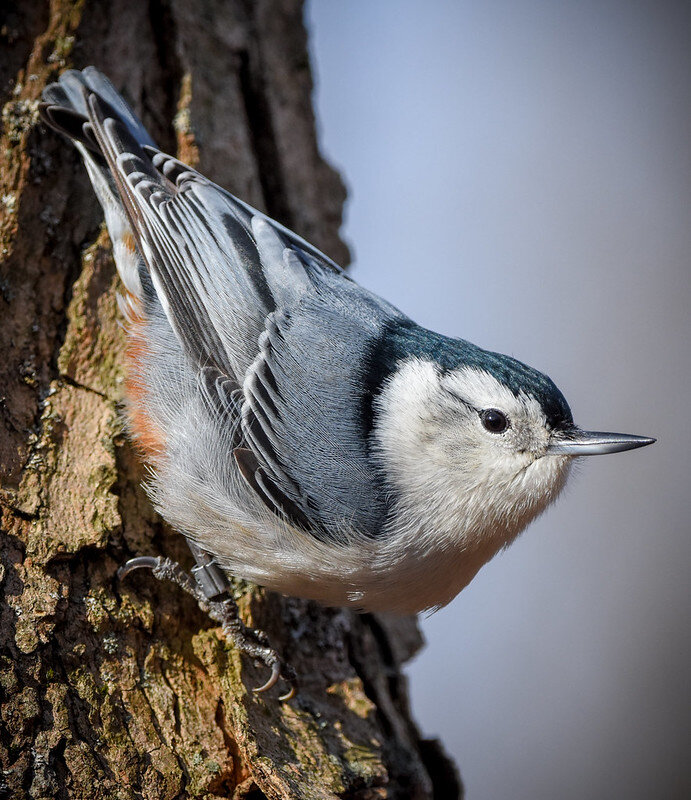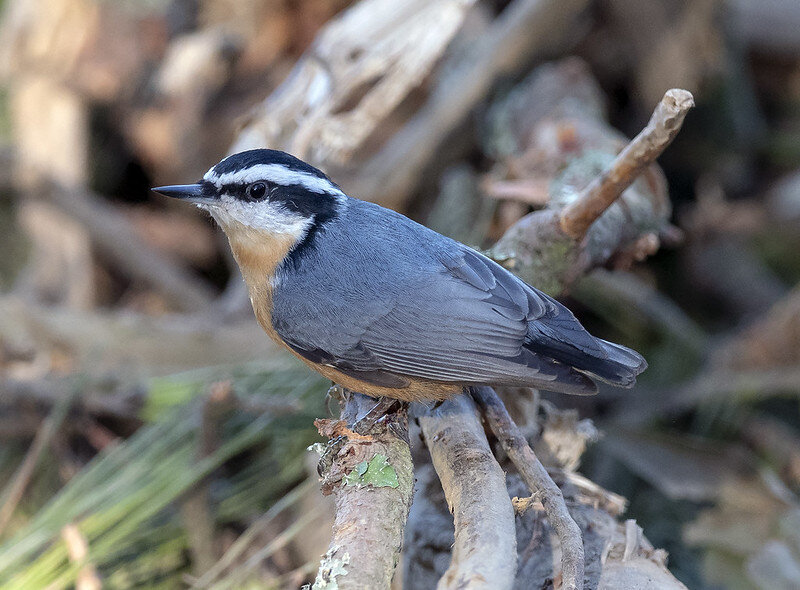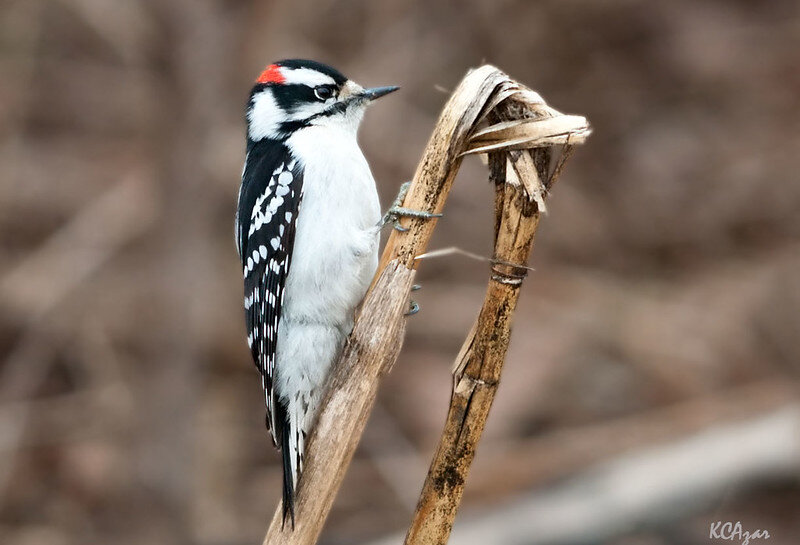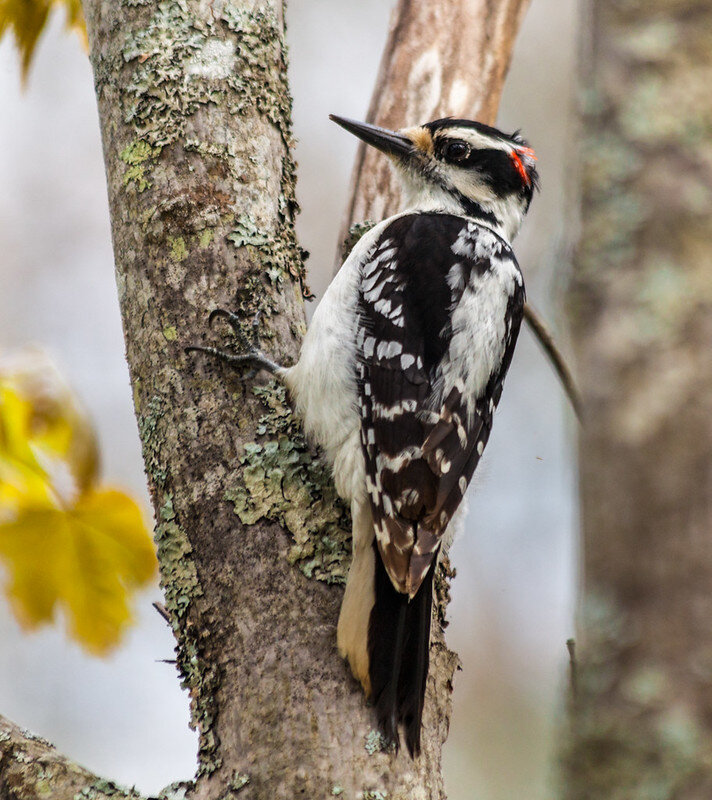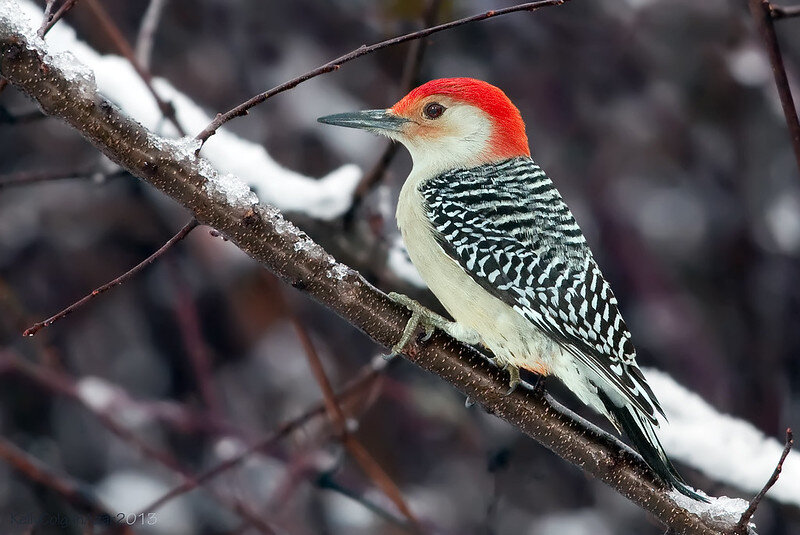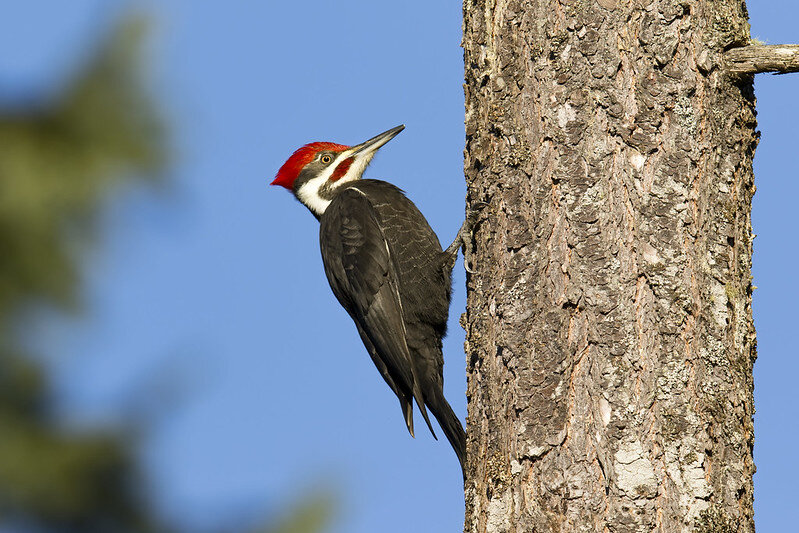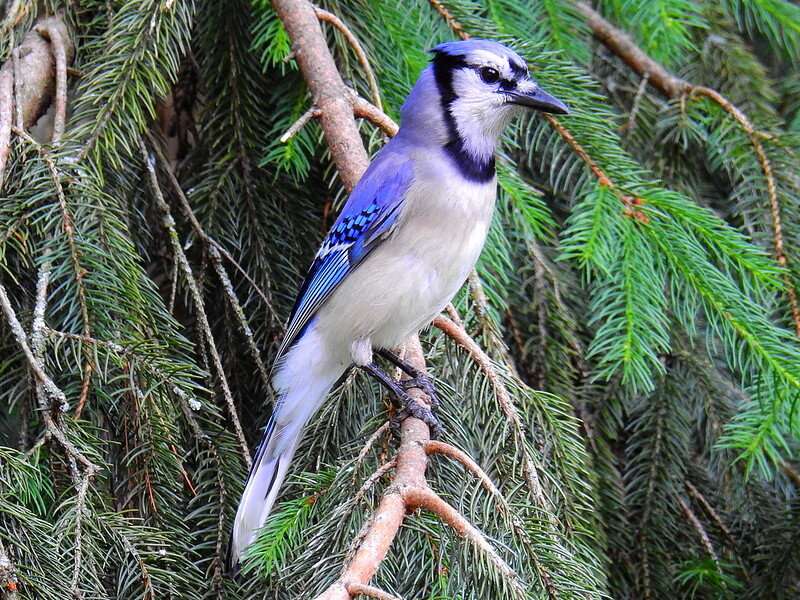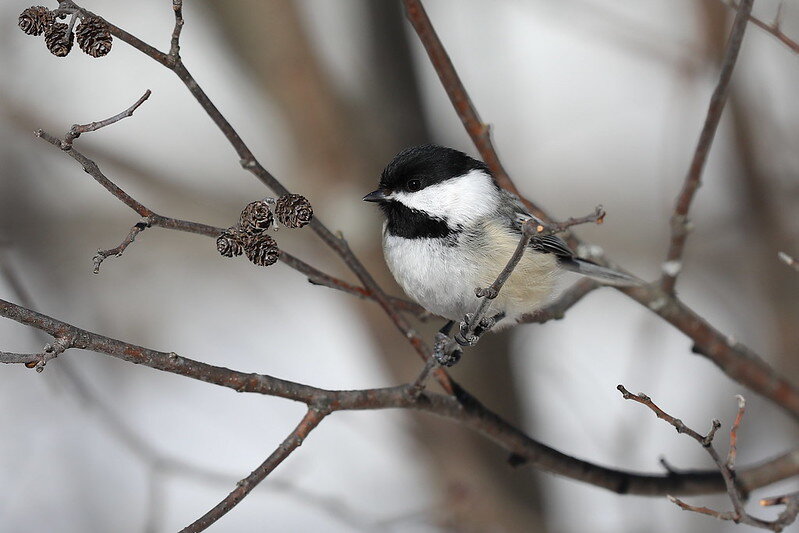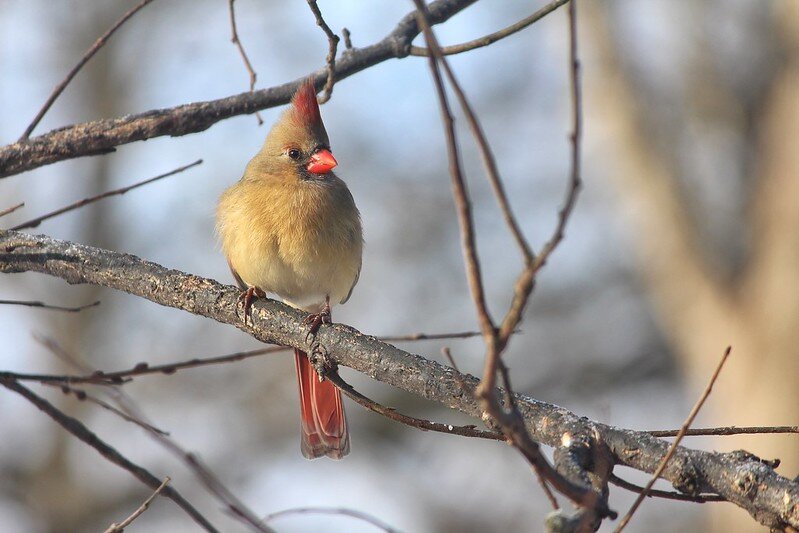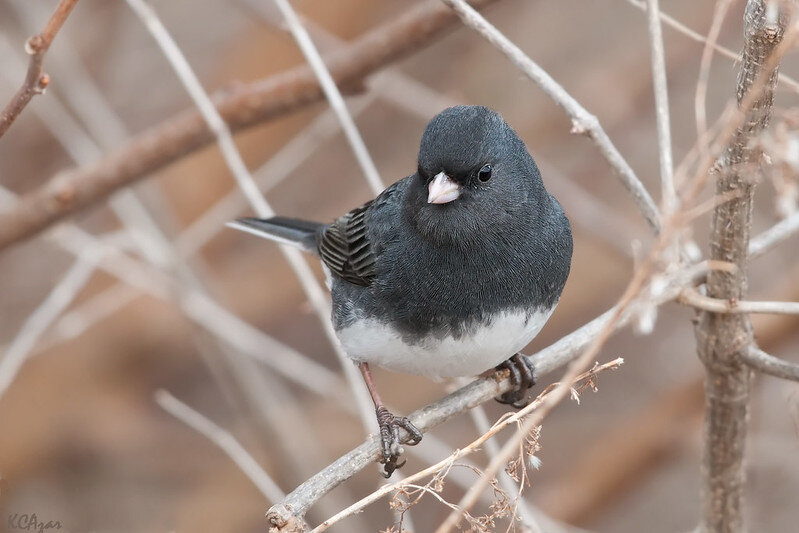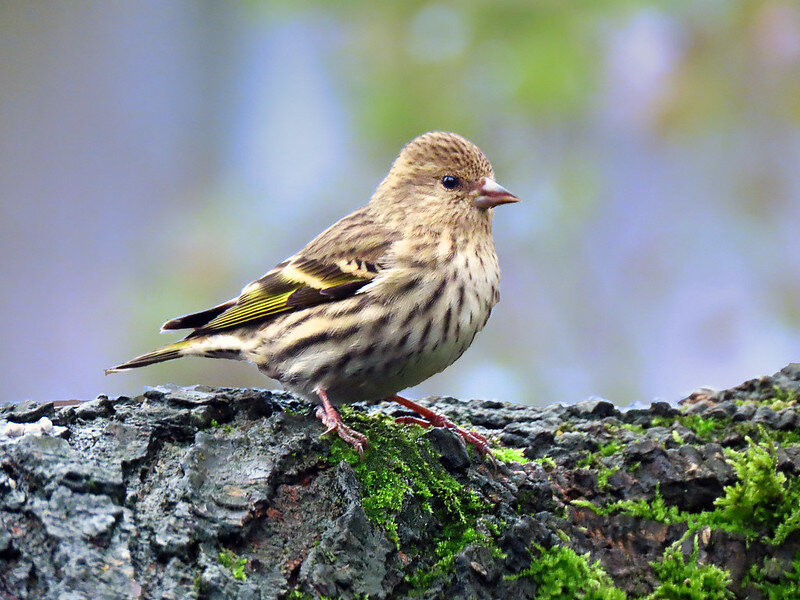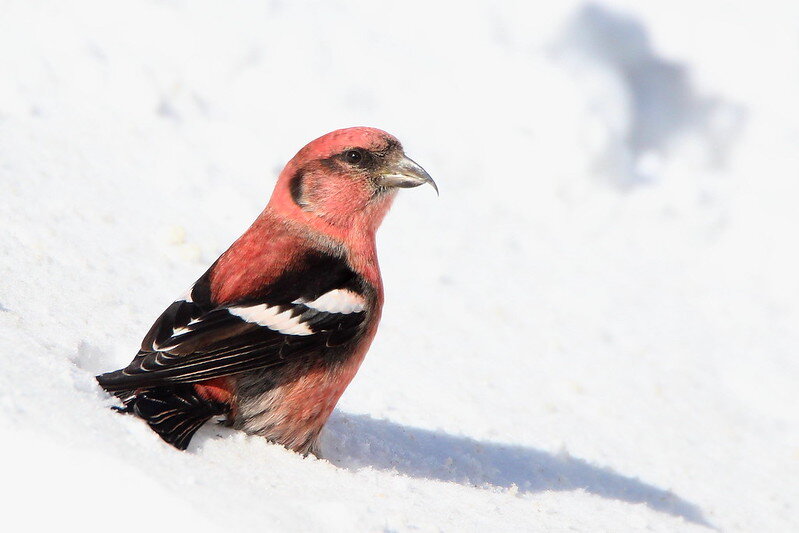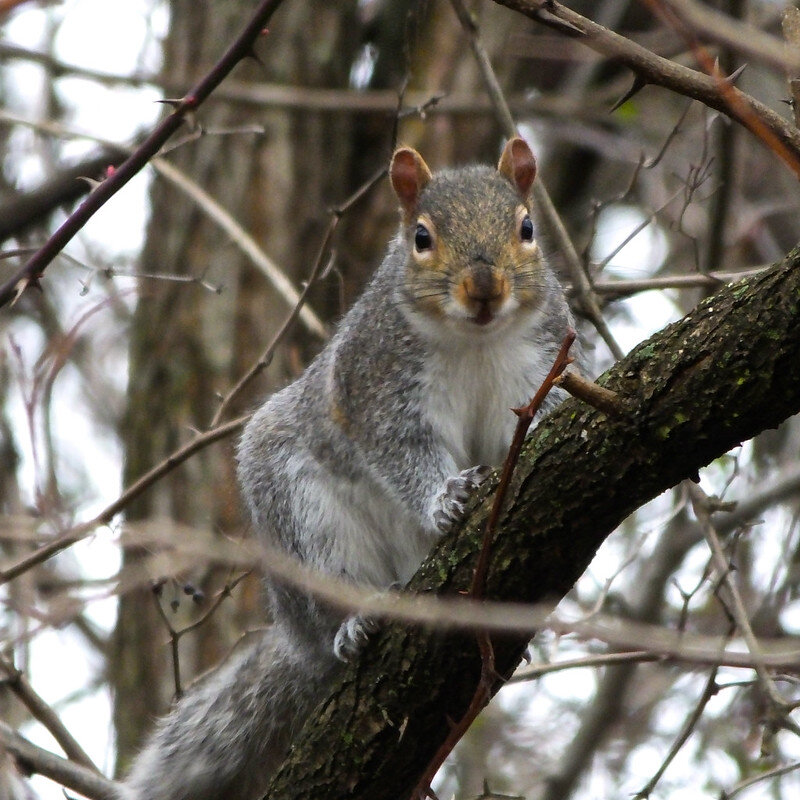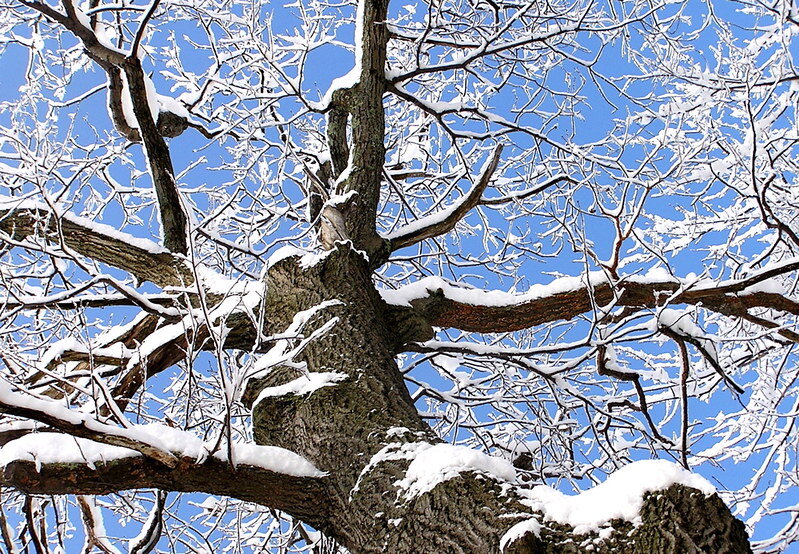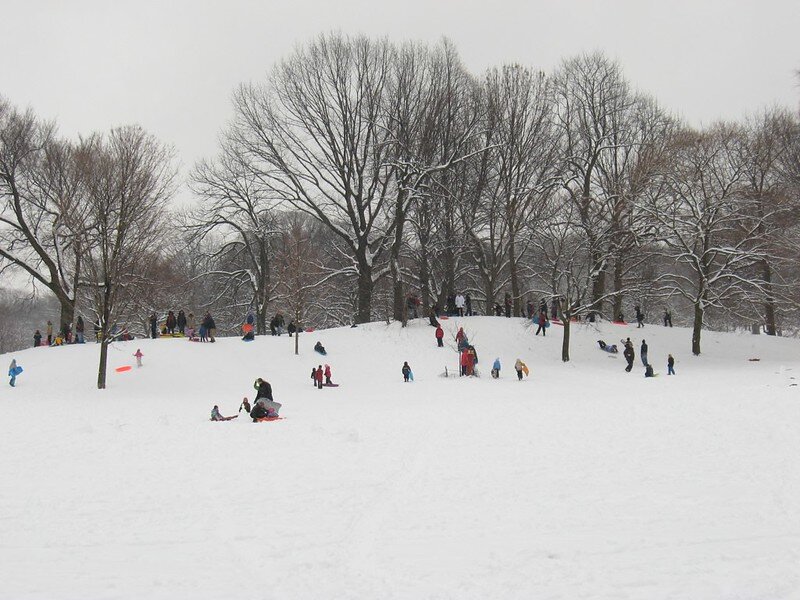Welcome back to the Entryway to Birding blog! Last week, we returned to the north unit of Cherokee Marsh to get an example of what your average winter birding outing might look like. Winter bird activity certainly isn't as hustlin' and bustlin' as it is during spring migration, but it has its own special joys.
It also has some unexpected benefits. You'll likely see and hear fewer species on your outings in winter than in any other season, but that's not a bad thing. It's a hidden opportunity. If the woods are mostly quiet, it gives you more opportunity to really learn and recognize the birds you do hear. Many newer birders struggle with birding by ear (I know I sure do!) but winter is a great time to improve this skill.
Birding by ear is hard, but this week's Entryway to Birding blog brings you some pointers and mnemonics to help you sort out who's-who on your winter outings.
Downy woodpeckers are one of the most common woodpeckers I tend to find on my bird outings. I especially love to find them drumming on things that seem way too small or weird to drum on. If I hear any very light drumming—almost more like tapping—I start looking around for a downy. Photo by Nick Busse
The Challenge of Birding by Ear
Some folks take really well to bird songs and calls. I am not one of them. When it comes to birding by ear, I've found that I have to put in a lot of effort to study up and ask a lot of questions—repeatedly. This summer, I sent my friends recording after recording of songs that I didn't recognize ... and every single time, it turns out I had recorded an American goldfinch singing. (Me: "Goldfinch again?! Are you serious?!") I know their potato-chip, potato-chip flight call, but apparently that's all my brain can hold.
I get fooled by northern cardinals, one of our most common birds, all. the. time. They have a sharp, metallic chip call … but a lot of other birds make chip calls too and it’s not always easy to match up those short, quick calls. Don’t feel bad if you get fooled! Photo by USFWS Midwest Region
All this to say—please don't be discouraged by the challenges of birding by ear and please never, ever be embarrassed if you can't recognize a song or call, common bird or not. Birds make a lot of noises (which in turn can be highly varied), and keeping everything straight is tough. Just keep at it and remember you'll get better with time, patience, and practice.
And practice is what winter is for. Your options for what could be making that unidentified bird call are limited by the winter season—you're dealing with a smaller cast of woodland characters and that can make your birding by ear adventures a little easier.
I'm going to lay out a few different groups of birds you're likely to hear in the woods in winter in south-central Wisconsin and describe some tips you can use to remember some of their most common vocalizations. Most of these birds will be calling and not singing (yep, there's a difference!) but don't be too surprised if you suddenly hear a northern cardinal or a chickadee bust out a summer song—that happens!
I’ve included recordings from xeno-canto, a truly awesome resource of bird recordings submitted by users. It’s a great tool for exposing yourself to more variations in bird songs and calls, not just the “perfect example” that you’ll hear on many ID apps. But because of this, the volume is a little variable on each of these recordings — you may have to adjust up and down a little between recordings as you listen.
Now, let's see who we are dealing with.
Know Your Nuthatches
White-breasted nuthatch by Jenn Goellnitz / Red-breasted nuthatch by Doug Greenberg
The white-breasted nuthatch is a year-round resident in Wisconsin and one that will sing late winter, so you’ll hear both their rapid wa-wa-wa-wa-wa-wa song and their nasal yank yank yank call this time of year, but the red-breasted nuthatch will only visit us in fall and winter. Red-breasted nuthatches are somewhat of an "irruptive" species, meaning that some years, they'll travel further south in greater numbers and in other years, we may get none at all. This year, there are plenty of red-breasted nuthatches to go around!
Both these birds have a nasal-like quality to their calls—plug your nose and say "yank" to get an idea of what I mean—but they say "yank" with a slightly different accent and rhythm.
The white-breasted nuthatch will give a loud, nasal yank yank yank (not necessarily three times, but a few times in a row, often with pauses). It has a slurred, rather than sharp quality to it—kind of like the bleating of sheep, rather than a sharp honk of a car horn.
The red-breasted nuthatch, on the other hand, gives a nasal yank-yank, yank-yank (repeated quickly, many times) that's described as "horn-like." Their call reminds me very much of a car alarm going off or a garbage truck backing up. It's a more succinct, rapid yank that makes the white-breasted nuthatch's yank-ing sound drawn out by comparison.
Habitat can also be a big clue when it comes to these species. Red-breasted nuthatches love pines and other conifers and you're more likely to hear them in places where there are ample pines. But that's not to say they can't be found elsewhere—this year especially.
Creep Those Creepers
You’re more likely to hear a brown creeper before you spot one of these well-camouflaged birds. Photo by Kelly Colgan Azar
I talked a little bit about how to recognize the brown creeper call in last week's Cherokee Marsh tour, but it's worth repeating because this is a bird whose call will likely be the first clue you have to its presence.
I liken the call of a brown creeper to the sound of a faint, softly-blown referee whistle. It's delicate, high-pitched, and trill-y. You may hear some very soft, high-pitched chips surrounding that longer "referee whistle”. If I hear this noise, it literally stops me in my tracks—like the brown creeper is the referee of my birding game and they've called for pause, because my new task is now to find them.
These tiny camouflaged treecreepers are a challenge, but an immensely rewarding one. But in the fall, their call can easily be confused for the similar sounding golden-crowned kinglet. Kinglets, though, seem to give a more rapid, jumbly series of these high-pitched notes. We don't have many golden-crowned kinglets in the middle of winter—though they aren't unheard of—but these two species overlap a lot in the fall and spring, so now is a good time to really tune your ear to the brown creeper call and learn it well.
Which Woodpecker?
Downy woodpecker and red-bellied woodpecker by Kelly Colgan Azar / Hairy woodpecker by Paul VanDerWerf / Pileated woodpecker by Mick Thompson
The bulk of the calls that you may be hearing in the woods in winter are going to be those of woodpeckers. If your experience is anything like mine, you might start to recognize the "essence" of a woodpecker call and be able to confidently say "That was a woodpecker!" but may struggle to remember which one you're dealing with. But hey, recognizing what may be a woodpecker is step one!
Downy woodpeckers give two calls you'll want to be familiar with. The first is a whinny-like or trill-like call—a series of very quick, sharp notes strung together—that descends in pitch. The descending pitch at the end of the call is going to be what sets their whinny apart from that of the hairy woodpecker, so remember: downy goes down!
Downy woodpeckers also give a single, sharp chip or "pik" note—but it is not as loud or as emphatic as the very similar sounding chip given by hairy woodpeckers. Their drumming may also be quieter—more of a tapping—because of their small stature and propensity to drum on smaller branches.
Hairy woodpeckers give a whinny-like trill call of repeated sharp notes too, but the pitch is steady from start to end—it doesn't go down at the end like the downy call. Their "chip" or "pik" note is loud, sharp, given with more gusto than that of a downy woodpecker.
Red-bellied woodpeckers do you a favor and set themselves apart with their calls. They give a rolling, husky churr churr call that doesn't have the sharpness of the downy's or hairy's trill. They may also give a cough-like or husky laugh that goes cha cha cha, which can sound like someone chuckling at a joke.
When it comes to pileated woodpeckers, your first clue might be their loud drumming—which you may hear even if they are on the other side of the woods. The drumming of smaller woodpeckers like the downy, hairy, and red-bellied is easy to pick up if you're in their general area, but the deep drumming of a pileated can cover some distance. You might hear their cackle-like laughing call too, a loud kak kak kak kak kak.
Woodland Basics
Blue jay by Ken Gibson / Black-capped chickadee by Aaron Maizlish / Northern cardinal by Mark Moschell / Dark-eyed junco by Kelly Colgan Azar
There are some other key characters of the woods you'll want to be familiar with. These birds are common, but often have several different calls that can easily trip you up.
Blue jays, for instance, are quite the mimics. They'll make a laundry list of calls—most commonly a harsh squawking jeer!—but they will mimic other birds to fool you and make lots of odd whistled noises too. You'll likely encounter them spoofing the scream of a red-tailed hawk. If you encounter any call that seems "odd" and you're struggling to place it, look around for these birds.
Black-capped chickadees are known for their chicka-dee-dee-dee call (with more "dees" to mark more alarm) but they make a lot of other strange pips and squeaks. I often get fooled by a weird bubbly, gurgle call they make. They also make some high-pitched tsee notes. Don't be surprised if you hear their whistled cheeeeese burg-er or hey sweetie—their common spring and summer song—given in winter. They just do that sometimes.
Northern cardinals are another bird that will sometimes sing in the winter, so you might hear their their whistled string of notes that gets described as cheer, cheer, cheer (which to me sounds less like cheer and more like a laser-esque pew pew pew). Their most common noise in the winter, though, will be a very metallic-sounding chip. They’ll often chip a lot, like a long string of chips that just keep coming.
Dark-eyed juncos, one of our most common winter sparrows, can be heard giving a long, even-paced chippy trill that lasts about two seconds—kind of like a chipping sparrow's song (except you won't be finding a chipping sparrow here this time of year). I also associate dark-eyed juncos with a fast flurry of very twittery chips—they'll make these very "twittery" noises when they flush, so listen for that as you see them dart from the path ahead into the brush.
Winter Irruption "Special Finds"
Pine siskin by Richard Griffin / White-winged crossbill by Scott Heron / Red crossbill by Eric Ellingson
Remember that good ol' winter finch irruption that's going on? You're quite likely to hear pine siskins this year—listen for their unique rising zreeeeee! call mixed into an otherwise mumbled jumble of wheezy notes. You might also (if you're lucky) hear white-winged crossbills or red crossbills, but both of these species have been infrequent in our area.
The challenge with white-winged crossbills and red crossbills is that they're flighty and move to new areas quickly, so you're most likely to hear them give their flyover calls as they pass over you. White-winged crossbills give a very mechanical sounding, typewriter-esque series of metallic rattles. I couldn’t find a xeno-canto recording of them, so click here to visit their Sounds page on All About Birds, and click the second recording (the first “call” listed).
Red crossbills give a quick, dry kip kip kip, kip kip kip that may sound "finchy" but faster than what you'd expect from a goldfinch.
“Mystery Birds”
Squirrel by Cam Miller / Tree branches by Liz West / Children sledding by Jean Gazis
Have you ever played "Bird or squirrel?" It's a game that I often lose. In addition to squirrel calls, there are a lot of woodland noises that you can easily mistake for a bird. I'm pretty sure I spent at least five minutes trying to get a recording of a squeaky branch the other day. And if you're in any sort of park near a neighborhood, you might even find yourself fooled by the distant sound of children yelling and laughing as they play.
I find that because winter is so quiet, any noise—and I mean any—is something that my brain wants to transform into a bird call. That power of wishful thinking is strong. But no, my friends, that laughing child is not the laugh of a distant woodpecker.
Don't be afraid to let yourself be fooled, though—you'll learn from it and be better next time.
This isn't a comprehensive list of birds you may find or hear in the woods—nor a comprehensive list of the noises they make, of which there are many more possibilities and variations.
And we didn't even talk about owls, who will get very vocal this time of year as they begin their mating and courtship season. If you're birding late afternoons or early mornings, you may find their hoots, toots, and whinnies thrown into the mix. Check out our "Whoooo's That? Your Winter Guide to Owls" post from a few weeks back to get some insight on what you might hear from them.
My best advice is likely advice you've heard me or others share before: to learn a bird's calls or song, watch it as it vocalizes. So if you hear what you think may be a woodpecker, take the time to stop and find it. Try to keep your eyes on it when it calls or trills. Soak up that moment. The more you take the time to slow down and deliberately familiarize yourself with each bird and each call, the more you'll remember.
And then, when spring migration arrives and a whole slew of other bird songs come with it, you'll be able to sort out what you do know from what you don't. So take advantage of the limited species we have here this winter—learn them and learn them well, so you can start with a new set of birds this spring.
That's all for this week. Happy birding by ear!
_____
Caitlyn is the Communications and Outreach Assistant at Madison Audubon. She’s crazy for birds because they changed her life. She’ll be back next Monday with some tips and tools for birders, new and experienced! Between now and then, she’d love to hear about the birds you’re seeing and hearing. Leave a comment below or email to drop her a line!




